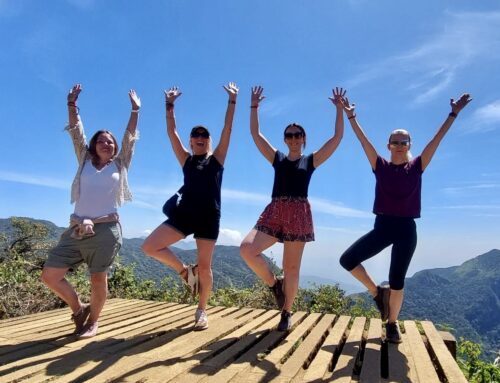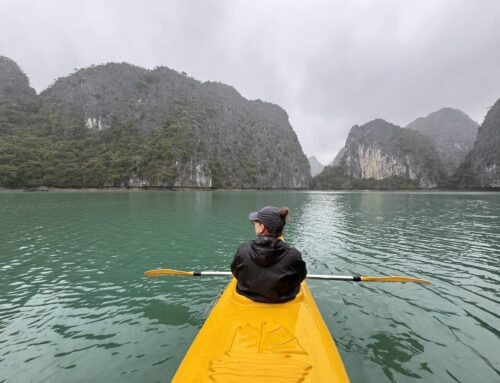Dr Nicola Cann, Educational Psychologist & Regular Contributor
As a self-confessed adrenaline junkie, adventure tourism is very appealing to me. In fact I’m writing this article from a cafe in Da Nang, Vietnam, before heading off for a surf lesson. From the mountain-climbing explorers of the 1800s, to Sir Edmund Hillary and Tenzig Norgay’s lauded ascent of Everest in 1953, and the recent Titanic submarine implosion that made global news, people are always pushing the boundaries of what is physically possible. But in recent decades adventuring has become increasingly mainstream, and adventure tourism is now one of the fastest growing sectors in the tourism industry.
Since borders around the world have reopened and exotic and far-flung places are once again more accessible, it is estimated that this niche market may be the biggest tourism sector by 2030 (Adventure Tourism Association, 2014).
What is adventure tourism?
Last year I climbed a volcano in Bali and camped on the side of the mountain overnight to watch the sunrise the following morning. Sounds adventurous right? Except that the following morning the mountainside was filled with hundreds of other tourists who had wandered up that morning for the same purpose. As the crowds wandered past my tent, all saying a cheery ‘good morning’, I reflected on what constitutes an adventure.
The Adventure Travel Association says that adventure tourism must include at least two of the following:
- Physical activity
- Natural environment
- Immersion in a new culture
According to this definition adventure tourism is not necessarily about scaling dangerous mountains, or diving with great whites. It’s about connecting with a new culture or environment in a way that is exciting and stimulating. This usually equates to a travel experience that is in an environment that is unusual or remote, where the traveller will experience challenges, novelty, excitement and a sense of discovery. These travel experiences tend to include a high level of physical and sensory stimulation, and a perception that you are taking risks.
Typically tourism experts categorise adventure tourism as either ‘hard adventure’ or ‘soft adventure’. Hard adventure tourism includes high risk activities that require lots of preparation and skill. Think free diving, mountaineering, and caving in uncharted territories. These experiences also tend to be pricey. For example climbing Mount Everest will set you back around $20 000, and that’s assuming you already have all of the gear. There are also strict criteria for the required permit, so this type of adventure is inaccessible for most people.
But you don’t need to be a wealthy adrenaline junkie to enjoy adventure tourism. Soft adventure tourism still has a perceived risk but it is generally lower and therefore more accessible. Soft adventures might include kayaking, backpacking, or parasailing. Of course there is still some risk involved in these activities, but the difference is that you can participate with minimal or no experience and preparation, and you’re likely to be led by an experienced guide. me
These categories can be problematic because the level of risk can be highly subjective. For example, a tough hike for an experienced hiker will feel much less adventurous than it will for a novice hiker. So in reality these categories are blurry and somewhat subjective.
The psychological appeal of adventure tourism
The reported benefits of adventure tourism are impressive, including enhanced mental and physical fitness, increased self-confidence and personal growth. But it’s not for everyone. You are most likely to enjoy adventure tourism if you are:
- a natural risk taker
- high in curiosity
- open to new experiences
- extraverted
- a sensation seeker
(Tok, 2011)
The need for adventure is often fueled by the desire for escape from boundaries and daily social constraints, which is achieved by disconnecting from your usual environment. So our need for adventure may be inherently related to the amount of perceived adventure in our day-to-day lives. What feels like a risk for one person may not feel like a risk to another person, and what constitutes a new experience for one traveller may not be new for another. For example if you’ve never eaten street food in Hanoi this could constitute an adventure for you. But if you lived in Hanoi for five years and you ate street food every day you were there then it would not.
How to have an adventure
Not sure if adventure travel is for you? Having an adventure doesn’t need to break the bank or involve high risk activities. In fact ‘microadventures’ can facilitate similar psychological benefits to the more obvious high-adrenaline experiences. Here’s how:
- Cultivate a novelty mindset: If the goal is to disconnect from everyday life you can do this in simple and inexpensive ways. Find adventure in your day-to-day life by trying that new food, signing up for that dance class you’ve been putting off, or exploring that part of town you’ve never been to.
- Shift your frame of reference: Adventure doesn’t need to happen in far-flung places. We can find it close to home. Focusing on having local adventures can result in deeper connections to our communities, and has the added benefit of keeping your carbon footprint low.
- Consider a ‘little-but-often’ approach to adventuring: Weekly microadventures can be more achievable and more affordable than an exotic and extended trip every five years, and the research suggests that these may result in more enduring psychological benefits.
- Know and respect the limits of your comfort zone: This will allow you to identify the level of adventure you need in order to reap the benefits. Your comfort zone is highly individual and there is no need to do something so scary that you don’t enjoy it.
- Do your research: Don’t be the tourist that needs airlifting off of the mountain because they overestimated their skills. Take responsibility for knowing if you have the skills and capabilities for the adventure you’re planning.
- Don’t go it alone: If a guide is recommended for your activity, find an experienced and reputable one. An expert guide will understand more about the activity than you can hope to. They will look after you and ultimately you will have a better experience. Aside from this, hiring local experts is great for the economy of wherever you are choosing to have your adventure.
- Tell people about your trip: This one is not just about the social media bragging rights, although that can be appealing too. Making sure people know where you are and what you’re doing adds a layer of safety, so make sure someone at home has the details.
Happy adventuring!
References
Tok, S. (2011). The big five personality traits and risky sport participation. Social Behavior and Personality: an international journal, 39(8), 1105-1111.
Global report on adventure tourism. (2014). Adventure Travel Association. Retrieved August 16, 2023, from https://www.e-unwto.org/doi/pdf/10.18111/9789284416622.
If you liked this article, check out Dr Nicola’s previous post Why do holidays make us happy?





